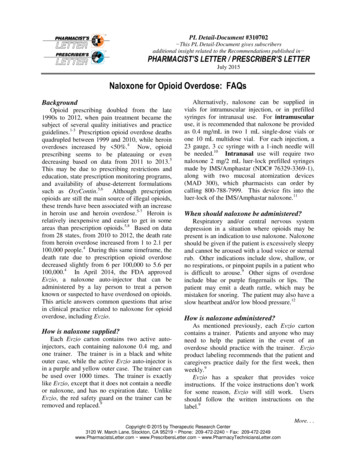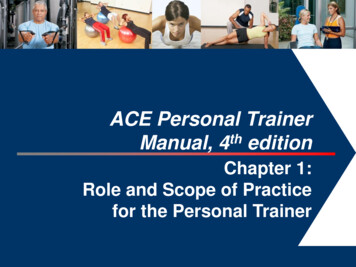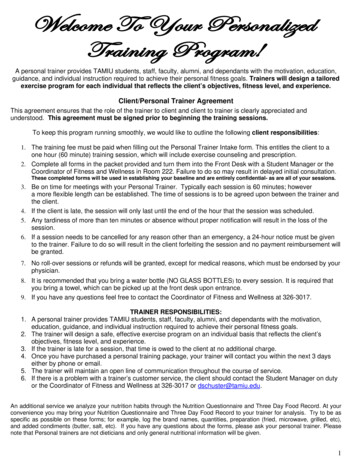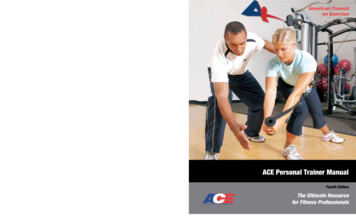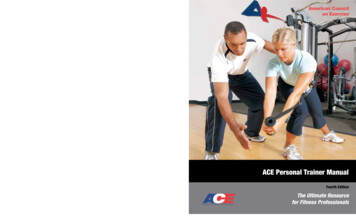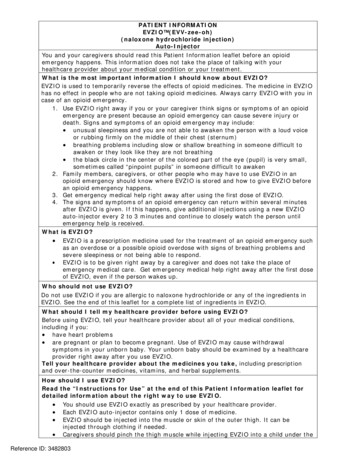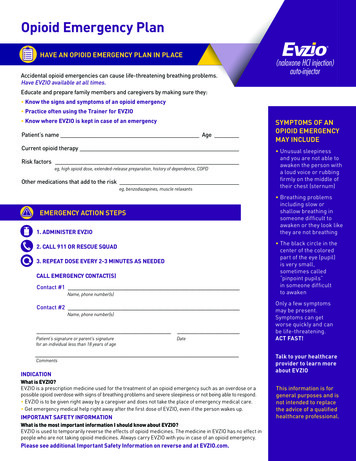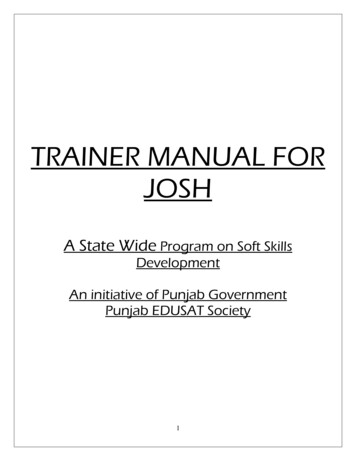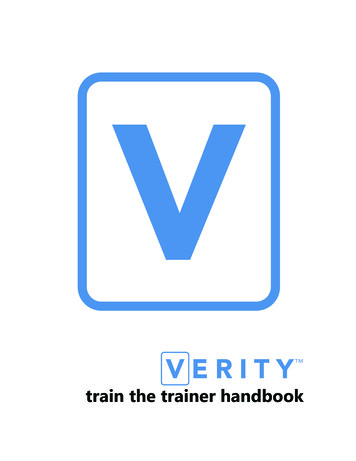
Transcription
train the trainer handbook
Hart InterCivic Quality and Information Security PolicyHart InterCivic is committed to consistently providing high quality products and services for its customers through adherence to its established hardware and softwareQuality Management Systems, complying with customer, statutory, and regulatory requirements, and a commitment to continual improvement. Hart InterCivic is also committed to the integrity and the security of the information used in the product development process, in the products themselves, and in our management of customer dataduring the implementation process.This DOCUMENT and the SOFTWARE, HARDWARE, and FIRMWARE to which it pertainscontain confidential and proprietary information belonging exclusively to Hart InterCivic, Inc. No part of this publication may be modified, reproduced, stored in a retrievalsystem, or transmitted in any form, distributed by any electronic or mechanical means,photocopied, recorded, or otherwise reproduced or distributed without prior writtenpermission from authorized personnel at Hart InterCivic, Inc. Any person receiving thisdocument has a duty to take reasonable precautions preventing unauthorized use ordisclosure of the contents.TrademarksHart InterCivic and Verity are registered trademarks of Hart InterCivic, Inc.Hart InterCivic disclaims any proprietary interest in the marks and names of others.Hart InterCivic, Inc.15500 Wells Port DriveAustin, TX 78728Help Desk: 866.275.4275 (866.ASK.HART)eFax: 512.252.6925eMail: hartsupport@hartic.comHart Support Online: https://hartsupport.hartic.comDocument Number 6661-008 A 2015 Hart InterCivic, Inc.All Rights Reserved
train the trainerhandbookversion 1.0
4contentscontents8introductionabout Train the Trainer8what is Train the Trainer?.8this document.9objectives.9course descriptions10Polling Place Operations.10Assisting Persons with Disabilities.10Hart resources11other documentation.11
51 training theory and practicetraining theory1212principles of human learning.13working with adult learners.13Knowles’ principles of learning.14the six stages of learning.15the Hart 5-stepteaching method16basic training rules.2223course presentation methodsthe audience.23the introduction.24course packs and guides.25the hands-on exercises.26the review.26resetting and packing equipment.2728course planning and2 system expertiseplanning overview28course agendas.28the ideal environment.30preparing equipment.33predefining checklist.33
contents6course content:34course content:Assisting Persons with Disabilities35system expertise36Polling Place OperationsVerity security features.36Verity hardware strengths.37Verity system components.38security recommendations.39troubleshooting approach.40glossary42simulation & assessment tools66sample simulationexercise checklist67poll worker self assessment69
7
8introductionintroductionabout Train the TrainerThis document and the training course it supports are theVerity instructors’ guide for successfully implementing Veritypoll worker training. Use this manual to plan and prepare forsuccessful training events. Since the Verity Train the Trainertraining course supports all Verity products, not all of theprocedures in this document apply to all implementations.You must identify applicable procedures for the voting devicesimplemented.what is Train the Trainer?The Verity Train the Trainer training course provides localelection officials and staff with the knowledge and techniquesnecessary to conduct poll worker training using the Veritysystem.
9this documentThis document is both a training guide and a handbook toassist local jurisdiction personnel training functions. Thisdocument is intended for use during initial training with HartInterCivic training specialists and as a reference guide onceinitial training is completed.objectivesThe purpose of Hart InterCivic’s Verity Train the Trainer trainingcourse, which this document accompanies, is to demonstratehow to successfully plan and perform polling place coursetraining events appropriate to the jurisdiction.In the course associated with this document, you will acquireteaching knowledge of the Verity Voting system trainingcourses in Polling Place Operations and Assisting Personswith Disabilities. You will also learn.basic training theory and methodologies toprovide you with a foundation.how to create a training climate that encouragesquestions and participation.how to use training time wisely and thoroughlycover all objectives in the courses taught.how to adjust training to meet the learners’needs.how to use testing and evaluation feedbackprocedures to assess effectiveness of trainingand to modify methodology, personal approach,materials, etc.how to follow training planning procedures
10introductionVerity course descriptions(taught by election officials and staff)Polling Place OperationsThe Verity Polling Place Operations trainingcourse provides poll workers with an overviewof the Verity system, the benefits of using Verity,and polling place procedures.In this course, Trainees learn to successfully:XX Set up the voting equipmentXX Open pollsXX Instruct and assist votersXX Suspend/Close pollsAssisting Persons with DisabilitiesThe Verity Assisting Persons with Disabilitiestraining course provides poll workers with theknowledge, awareness, and sensitivity neededto instruct and assist persons with disabilitiesusing the Verity Touch and Touch Writer.After completing this course, trainees willsuccessfully instruct and assist persons withdisabilities in the accessibility features of theVerity Touch and Touch Writer systems.
11Hart resourcesCustomer support for Verity products is available viathe Customer Support Center Help Desk as well asonline:Customer Support Center (CSC) 1.866.275.4278 hartsupport@hartic.com 7am-7pm CST M-F extended hours during election eventsHart File Transfer (HTS) (secure file transfer service)other Hart documentationIn addition to this handbook, the followingdocumentation is also available from Hart: Verity Polling Place Operations GuideStep-by-step training guide and reference foroperation of the Verity Voting system in the pollingplace. Verity Poll Worker’s Field GuideA condensed, portable handbook covering pollingplace procedures. Verity Course PacksTraining Agendas and PowerPoint presentations foreach of the Verity training courses.For a complete list of all available documents, see the Verityproduct catalog.
12training theoryand practice1training theory andpracticetraining theoryAs a Hart Voting System instructor, you areresponsible for your students’ learning. Thinkabout the following sets of learning principles,theories, and procedures and how they mightapply to you as you plan and teach.XX The five principles of human learningXX Ten characteristics of adult learnersXX Knowles’ principles of adult learningXX The six stages of learning
13The five principles of human learningTrainers can help facilitate successful training eventsby remembering:1 A learning activity should be goal-directed2 People learn what they practice3 Learning is built upon the foundation of theprevious step4 Learners must make a personal connection5 Activity and interest must be highTen characteristics of adult learnersTeaching adult learners carries its own specificchallenges. Generally speaking, adult learners.1 Must see the purpose and benefits2 Need positive reinforcement3 Must practice to retain information4 Associate new skills with past experiences5 Engage in learning that helps them cope with lifechanges6 Require clear expectations7 Demand comfort and breaks8 Need to see successful application of tasks9 May be impatient and want to “move on”10 Can be quick to evaluate good teaching
14training theoryand practiceKnowles’ principles of adult learningPracticalityActivities should be practical and “hands-on”. Experience(including mistakes) provides the basis for the learningactivities. Since many adults are more self-directed, instructionshould allow learners to explore the practical application ofknowledge, with the instructor providing guidance whenmistakes are made.RelevanceAdult learners need to know “what’s in it for me?” Adults aremost interested in learning subjects that have immediaterelevance and impact to their job or personal life. With adultlearners, you may need to explain the reasons specific thingsare being taught.Past ExperienceAdult learners (as well as the instructor) should tap into theexperiences of other learners. Adult learners have a wide rangeof background experience and abilities. Teaching approachand activities should allow for different levels and types ofprevious experience.Task-orientedAdult learning is problem-centered rather than contentoriented. Instructors should facilitate, not just deliverknowledge. Adult learners need clear objectives. Instructionshould be task-oriented, with learning activities placed in thecontext of common tasks that the learners will perform.
15The six stages of learningA Verity instructor’s goal is to assist trainees inacquiring the skills and knowledge to reach atleast stage four, and preferably stage five or six,in this hierarchy.
16training theoryand practicethe Hart 5-step teaching methodThe Hart training method consists of proveninstructional practices that implement thetheories from the previous pages in a practicaland productive manner.1 Tell2 Show3 Hands-on4 Review5 Elicit QuestionsUsing all five steps in your training session isan excellent way to encourage structure in yourtraining plan and improve knowledge retentionamong trainees.
171 TellObjectives: Clearly explain the objectives and benefitsof the system for each course, using proper terminology- what will you teach?Purpose: Tell trainees why they are doing things, andhow the training will it help them do their job and/ormake the job easier - why does the trainee need tolearn this?Expectations: Set expectations for yourself and trainees- how will you teach, and how will they learn?
18training theoryand practice2 ShowUse multiple methods to visually instruct thetrainees. Use the projector and PowerPoint presentations and/or video presentations todemonstrate each module’s teaching pointsfor the trainees. Walk through each lesson andgive trainees reference page numbers in theirguide and time for note taking when possible.Demonstrate the equipment, and explain whatyou are doing, as you do it.
193 Hands-onHands-On Set up and conduct hands-on exercises for yourtrainees. Hand-on experiences results in thehighest level of information retention. Whenever possible, keep the trainee/equipmentratio low so that all trainees have time topractice. Hold trainees accountable - keep them ontask and ensure that, when working in teams,trainees share responsibility.
20training theoryand practice4 ReviewReview the objectives, purpose, process steps,and key points. Review sessions are helpful forsmooth transitions between modules and helptrainees focus on the most important informationbeing presented.
215 Elicit QuestionsUse positive reinforcement, encourage discussionand questions, and facilitate participation byasking questions of the group.To help the class run more efficiently, you canencourage trainees to write down any questionsnot appropriate to the module being discussed(the “parking lot” method) and direct discussionof those questions to a designated at the end ofthe presentation.
22training theoryand practicebasic training rules Dress professionally Use training documents Start on time Tell objectives and steps Encourage questionswhen appropriate Remain flexible Work with your strengths End on time No cell phones Telling alone is not training
23course presentation methodsThese are the recommended methods forteaching the poll worker courses included inthe Verity training program. These methodshave proven successful. The course instructor’smain resources for providing structure andorganization to the training event are: The relevant Verity Course Pack, including thecourse agenda and PowerPoint presentation The Verity Polling Place Operations Guide and/orVerity Poll Worker’s Field Guide, as appropriate forthe implementationElements to take into consideration whenplanning course presentation methods include:1. The AudienceThe Verity Polling Place Operations trainingcourse is the core polling place system coursefor poll worker training. Trainees are pollworkers who will either be directly operating theequipment during an election event or directingothers on how to do so. Key points to stressinclude using the procedures in the Verity PollingPlace Operations Guide. As an instructor, it is
24training theoryand practiceimportant to reference specific page numbers inthe guide as you teach each module/exercise.During hands-on exercises, have trainees usethe guide to direct their actions. One techniqueis to assign a lead role to one trainee per labstation, per exercise. Have this role rotate forthe next exercise. The leader will direct the othertrainee(s) using the guide.Trainees for the optional Assisting Persons withDisabilities training course may be lead pollworkers or a select set of all poll workers. Thegoals of this course are: To provide poll workers with the knowledge, awareness,and sensitivity needed to assist persons with disabilitiesusing the Verity system. To increase poll workers’ knowledge of, and confidencein, the accessibility features of the Verity system.2. The IntroductionIntroduce yourself, set the expectations andobjectives for the course, preview the schedule,including the break, and orient trainees to thetraining facility. Make certain that all traineessign in, and verify that each trainee has theVerity Polling Place Operations Guide or otherdocumentation as appropriate for your courseplan.
253. Course Packs and GuidesEach Course Pack includes a PowerPoint presentation that accompanies and supportsthe training as well as a course agenda. Thepresentation is consistent with the courseagenda and the Verity Polling Place OperationsGuide. The presentation provides visual learnerswith a means to learn, but it is NOT intended toprovide instructors with a script.The course agenda provides instructors witha lesson plan, while the Verity Polling PlaceOperations Guide provides the details, and thepresentation provides visual cues.Following the course agenda, teach usingthe PowerPoint presentation as a visualreference. The presentation also providessome structure for the course (exercises,modules, etc.). Demonstrate tothe entire class, using actualequipment, whenever possible.Refer the trainees to the specificpages in the Verity Polling PlaceOperations Guide relevant to thekey points as you teach.
26training theoryand practice4. The Hands-on ExercisesBefore beginning hands-on exercises, be sure to: Give direction to trainees beforehand Give clear expectations for the outcome of thehands-on exercise Keep group size small if possible Send the same group to the same equipmentset up for each exercise Walk around the room and monitor the progress of each group Remind trainees to use specific pages ofthe Verity Polling Place Operations Guide (orVerity Poll Worker’s Field Guide) that pertainto the exercise Tell the trainees what to do when they finishthe exercise5. The ReviewIf you plan to administer a self-assessment testto trainees, be certain that there is ample timeallowed at the end of the course. While traineescomplete the assessment, the instructor(s)should reset the equipment for the next class,if applicable. Ideally, assessments should bechecked with trainees present, if time permits.
27Assessments may be collected from each traineein order to document individual performanceand identify polling locations that may needfurther training and/or assistance during theelection event.6. Resetting and Packing EquipmentA reality of training in an equipment-relatedcourse is that the equipment has to beready for the next session (or the warehouse)upon completion of a class. Equipment shouldnot be packed until it is reset and prepared forthe next class, or for storage. If youare teaching multiple courses on thesame day, after equipment is reset,it should be packed (or left set up)so that it is in the same location,in the same condition, that it wasin at the beginning of the firstcourse.
28course planning &system expertise2course planning andsystem expertiseplanning overviewCourse agendasIn addition to the course content itself, CourseAgendas also contain the following informationto help you plan your training session: Estimated time Materials and documentation needed Course prerequisites: make sure trainees havethe appropriate background for the courseyou are teaching
29planning overview, continued Recommended teaching methods for eachmodule Equipment Lists Sample Classroom Layout
30course planning &system expertiseThe ideal training environmentConsider all possible training constraints andcontributors: space, time, trainees, equipment,and documentation. Space: Where will you train? How will you setup? Time: How long will you have? Trainees: What is the class size? Equipment: What do you need? Documentation: What will trainees need?SpaceReview the course agenda specific to thecourse being taught. Each agenda includes anequipment list and a classroom layout graphic.Plan for enough space for a group instructionarea, hands-on exercises, and movement ofequipment.TimeYour schedule will be full. Be efficient with yourtime, especially time spent moving trainees inand out of the classroom. Be specific aboutbreaks, and start on time after a break. When
31taking a break, state not only the length of thebreak, but the return time. Do not wait for alltrainees to return, if they are running late. Timemanagement could be a major issue if you are ina situation where you are training fora large jurisdiction. You may needto modify your timing in orderto move more slowly througha module, or more quickly.Timing notes are included incourse agendas.TraineesMake certain that the people in the class arethose that need to be assigned to that course.Use a sign-in sheet to keep track of trainees.Compare the sign-in sheet to the roster, if aroster is available. Retain the sign-in sheet forrecord keeping.EquipmentThe hardware you use during training mustbe the same type of equipment used in anactual election. You must conduct training sothat trainees have hands-on experience with
course planning &system expertise32polling place components. Thisrequires enough equipmentso that there is a low traineeto-equipment ratio. A suggestedlist of equipment and trainee/equipment ratios is included witheach specific course agenda.DocumentationThe standard training document is the VerityPolling Place Operations Guide. This documentfunctions as both a training tool and as areference for operations in the polling place.Other documentation may be included intraining, such as: poll bookslabelslogsother polling place paperworkA suggested list of documentation is includedwith each course agenda. Consult your HartInterCivic project manager if you need assistancein obtaining up-to-date documentation.
33Preparing equipment You will prepare a test election for use withtraining, or (if you use Hart’s Ballot ProductionServices) procure one from Hart You will predefine the voting equipment usingvDrives and a Verity Key written for the test election; equipment predefinition instructions arefound in the Verity Support Procedures Guide; abrief checklist is given below:Predefining Procedure Checklist Power on the voting device Unlock the vDrive compartmentand insert a new, unvoted vDrivewith your training test election Select Yes, load new election and insert theVerity Key for your training test election Type the Verity Key password andwait while the election loads Type the Maintenance Code forthe election you are using Select the appropriate polling placefrom this list, then select Accept Select Yes, assign it to confirmthe polling place
34course planning &system expertisecourse content: Polling PlaceOperations(Verity Touch Writer & Verity Scan)Module 1: Getting StartedPresentation only, 5 minutesModule 2: Setting up thePolling PlacePresentation and Hands-On, 25minutesModule 3: Start of DayProceduresPresentation only, 5 minutesModule 4: Working with VotersPresentation only, 15 minutesModule 5: End of Day ProceduresPresentation only, 10 minutesModule 6: Simulated Polling Place ExerciseHands-on in groups with instructor guidance, rotating roles,45 minutesModule 7: Review and ConclusionPresentation and Q&A, 10 minutes/variable
35course content: AssistingPersons with DisabilitiesModule 1: Getting Started (Putting People First)Presentation & Discussion, 15 minutesModule 2: Assisting A Voter Who is Blind orVisually ImpairedPresentation and Hands-On, 20 minutesModule 3: Assisting a Voter with LimitedDexterityPresentation and Hands-On, 20 minutesModule 4: Assisting A Voter With Sip-andPuff DevicePresentation & Discussion, 10 minutesModule 5: Curbside Voting (Verity Touch Only)Presentation and Hands-On, 20 minutesModule 6: Polling Place Accessibility andTroubleshootingPresentation & Discussion, 20 minutesModule 7: Review and ConclusionPresentation and Q&A, 15 minutes/variable
36course planning &system expertisesystem expertiseIn addition to basic mastery of the Verity VotingDevices themselves, there are several othertopics relevant to polling place operations thatshould be covered:Verity security featuresProviding poll workers with information ondevice security features can give them greaterconfidence in the system they are learning touse. Verity Voting utilizes the AAA (authentication,authorization, and audit) security framework All Verity software has been tested by anindependent voting system test lab and theElection Assistance Commission to ensureproper security. Verity uses a multi-layered authenticationprocess Verity software is tamper evident Comprehensive audit logs are generated forall login attempts, data transfers, configurationchanges, and errors. Logs are storedredundantly and securely.
37 Vote records are stored redundantly for securityand auditability; The integrity of the data isprotected from power outage, power surge,magnets, and rough handling.Verity hardware strengths Innovative hardware is easy to store, transport,set up & operate Modern, shared interface design makes learningeasy Minimal steps required for testing, setup, andmaintenance Secure, integrated compact cases for devicesrequire less warehouse space Secure, lightweight ballot box that folds to 5”thin Lightweight, easy to assemble booth with minimal connections Everything fits easily in private vehicles
38course planning &system expertiseVerity system componentsInformation on each of the Verity Systemcomponents is found at the beginning ofthe Verity Polling Place Operations Guide.Components include:XX Verity Touch WriterThe Verity ballot-marking deviceXX Verity AccessThe Verity disabled access interface includedwith the Verity Touch WriterXX Verity ScanThe Verity polling place-based digital scannerXX vDrivesRemovable media for the Verity Voting devicesthat hold cast vote records (CVRs) and auditlog informationXX Verity KeyA security device used, along with a password,to authenticate certain actions in the VerityVoting system
39Polling place security recommendations Restrict access to votingequipment behind lockeddoors when not in use Ensure chain of custodywhen delivering or transferring any voting equipment or ballots. Maintain documentationfor authentication purposes containing serialnumbers, seal numbers, and identification to anyone tasked withdelivery or transport. Do not leave voting equipment unattendedwhen polling place is open. Put in place and follow local guidelines relatingto device seals and chain of custody procedures,including what to do if a seal is broken. Put in place and follow Access Code procedures.Do not issue Access Codes or ballots until voterhas been qualified and there is an available voting booth. Report any suspicious activity to the local election officer.
40course planning &system expertiseSystematic approach to troubleshootingSpecific troubleshooting steps are found in theback of the Verity Polling Place Operations Guide.Use the techniques below when approaching atroubleshooting situation:1 Remain calm2 Identify the issue or symptoms as reported3 Gather further information4 Think broadly5 Do not jump to conclusions6 Ask questions7 Establish a theory to explain the source of theproblem8 Research resolution steps based on yourtheory9 Use available documentation to identify theresolution steps10 Attempt resolution11 Check for success12 Repeat
41
glossary42glossaryabandoned ballotA ballot that the voter did not cast into the ballot box before leavingthe polling place. Local election rules dictate dispensation of anabandoned ballot. In some jurisdictions, abandoned ballots must bespoiled (see also spoiled ballot).absentee ballotBallot cast by a voter unable to vote in person at his or her pollingplace on election day.absentee votingA voting method by which people can cast their ballots without goingto the polling place on election day. In some jurisdictions, early votingis referred to as ‘absentee-in-person’ or ‘absentee walk-in’ and by-mailvoting is sometimes referred to as ‘absentee-by-mail.’acceptance testingExamination of voting equipment and testing of basic functionalityupon delivery including validation that the delivered system is, in fact,the certified system purchased.
43access codeThe five-digit number given to each voter that indicates to the Veritysystem which precinct and ballot style to display to the voter on theTouch Writer. The access code is printed by the poll worker from theTouch Writer that the voter will use. The access code is only valid for alimited time and does not link to any voter information.access code summary reportA report that is printed on the Touch Writer. It lists the number ofaccess codes issued, voted, expired, and canceled.adjudicationThe task of assigning the voter’s intent to votes on ballots that containan undervoted contest, an overvoted contest, a contest with a selectedwrite-in, or an invalid vote. Adjudication may also be required for acompletely blank ballot or a damaged ballot. Also called resolution.air gapA physical separation that describes how non-certified and certifiedvoting system applications relate to each other and manage data.A variety of methods can support a physical ‘air gap,’ primarily theabsence of any network connection between non-certified and certifiedapplications. These air gaps act as a physical firewall for all data andaccess ensuring integrity and security.Americans with Disabilities Act (ADA)A 1990 federal act that established comprehensive standards forthe treatment of persons with disabilities in employment, publicaccommodations, and other programs, including those operated bystate and local governments.audio ballotA ballot in which a set of contests is presented to the voter in spoken,rather than written, form.
glossary44audio-tactile interface (ATI)Voter interface designed to not require visual reading of a ballot. Audiois used to convey information to the voter and sensitive tactile controlsallow the voter to communicate ballot selections to the voting system.audit logA report containing recorded information that allows elections officialsto view the steps that occurred on the equipment and/or softwareincluded in an election in order to verify or reconstruct the user actionstaken without compromising ballot or voter privacy.authenticationThe verification of the identity of a person or process. In acommunication system, authentication verifies that messages reallycome from their stated source, like the signature on a (paper) letter.ballotThe official presentation of all of the contests to be decided in aparticular election.ballot boxA secure receptacle for the Verity Scan that collects scanned paperballots and that also has an emergency compartment for temporarystorage of unscanned voted ballots in case the Scan is disabled.ballot box security sealThe seal attached to the ballot box door to secure the paper ballots.See also security seal.ballot countA number, shown on the Verity configuration reports and Polls Openscreens that indicates how many ballots have been processed on thatdevice for the current election. The ballot count of a device is reset tozero when a new election is loaded by election staff before an election.
45ballot drop boxWhen voted ballots are collected from a physical box at a specificlocation, instead of by mail.ballot imageFor a paper ballot, the electronic digital picture of the ballot. For anelectronic ballot, the Cast Vote Record of the electronic ballot.ballot instructions(1) Instructional text that appears at the top of the ballot. There are twoseparate types of Ballot Instruction text: (1) Electronic and (
about Train the Trainer This document and the training course it supports are the Verity instructors’ guide for successfully implementing Verity poll worker training. Use this manual to plan and prepare for successful training events. Since the Verity Train the Trainer tra
